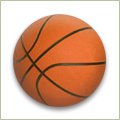
They found that:
Improving the Health, Fitness, and Performance of Young Basketball Players

Over the 16 years of the study, the rate of injury in a game situation was almost twice as high as the rate in practice. (This is not surprising since practices are a more controlled and *sometimes* less intense setting than games).
More than 60% of all game and practice injuries were to the lower extremities (hips, thighs, knees, ankle, feet).
In both games and practices, ankle injuries were the most common injuries. Of these, 30% were identified as being a repeat injury to an already injured ankle. (Please see my previous posts about ankle injuries and their rehabilitation and get yourself into an appropriate program so this doesn't happen to you!).
Other common game injuries included knee injuries (contact and non-contact) and concussions. Yep, that's right, concussions were 3 times more likely to occur in games vs. practices. This demonstrates that women's basketball is a fast-paced, physical game where heads, elbows and knees often collide.
Anterior cruciate ligamen (ACL) injuries accounted for 8% of game injuries - with more than half of them happening without contact. (There are many risk factors that cause female basketball players to have a 3-6 times greater incidence of ACL injuries. While some factors cannot be changed, there are neuromuscular training programs that have proven to be effective in reducing ACL injur risk and every basketball coach should know about them and integrate them into their players' training).
One other concerning finding was the increasing trend in the rate of stress fractures in the bones of the lower leg and foot. While this could be due to improvements in the technology used to diagnose these injuries, it can also be due to poor footwear (when are players going to stop wearing smaller versions of men's shoes and put on a well-made women's basketball shoe?) poor nutrition (anorexia, low calcium and vitamin D intake, etc.), and insufficient recovery time between games and training sessions.
The authors state that "As the size of players and the speed of the women's game continue to increase, basketball will complete the evolution from a finesse sport to more of a high-risk contact sport". I think that this has already happened and coaches, parents, and trainers need to work together to help reduce the risk of injury for these players so that they can continue to play, and learn from, the game.








